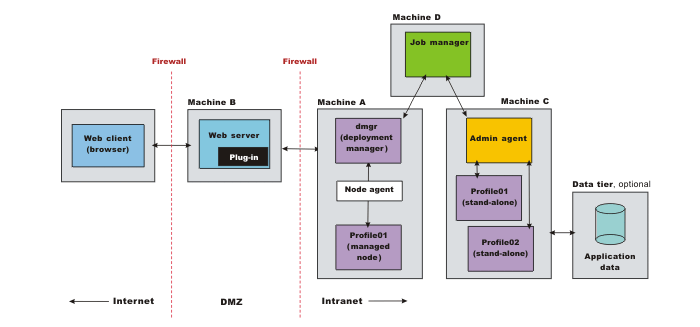Network Deployment (Distributed operating systems), v8.0 > Set up the application serving environment > Administer nodes and resources > Administer nodes remotely using the job manager
Job manager
In a flexible management environment, a job manager allows you to submit administrative jobs asynchronously for application servers registered to admin agents, for dmgrs, and for host computers. We can submit these jobs to a large number of servers over a geographically dispersed area.
We can register stand-alone application servers that are registered to admin agents, dmgrs, and host computers with the job manager. After you register stand-alone application servers, dmgrs, or host computers as targets, you can queue administrative jobs directed at the targets through the job manager.
To register application server nodes and dmgrs with the job manager, use an administrative console or the wsadmin registerWithJobManager command. The command is in the ManagedNodeAgent command group.
To register hosts with the job manager, use an administrative console or the registerHost command. The command is in the JobManagerNode command group.
New feature:
New feature: We can complete job manager actions and run jobs from a dmgr. The dmgr administrative console has Jobs navigation tree choices similar to those in the job manager administrative console.New feature:
Use the job manager to asynchronously administer job submissions. We can complete the following tasks:
- Set the job submission to take effect at a specified time.
- Set the job submission to expire at a specified time.
- Specify that the job submission occur at a specified time interval.
- Notify the administrator through email that the job has completed.
Each application server, dmgr, or host registered with the job manager is known as a target to the job manager. Groups of targets are those groups that you create so that you can make job submission easier. We can submit a job for a group of targets instead of entering multiple target names for a job.
Many of the management tasks that you can perform with the job manager are tasks that you can already perform with the product, such as application management, server management, and node management. However, with the job manager, you can aggregate tasks and perform those tasks across multiple targets.
Example uses of job manager
The following hypothetical company environments are examples of situations where a job manager is useful:
Example topology
The following example topology shows a dmgr and a federated node that is managed by the dmgr on machine A; two application servers, Profile01
and Profile 02, registered with an admin agent on machine C; a job manager on machine D; and a web server on machine B. Firewalls provide additional security for the machines. The admin agent and the dmgr are registered to the job manager. The admin agent and dmgr periodically poll the job manager to determine whether the job manager posted jobs that require action. Read the topic on planning to install WAS for further information on the topology.
 admin agent on machine C; job manager on machine D; web server on machine B." />
admin agent on machine C; job manager on machine D; web server on machine B." />
Administrative agent
Administer nodes remotely using the job manager
Administer jobs in a flexible management environment using wsadmin.sh
Administer nodes and resources
Create management profiles for job managers
Related
ManagedNodeAgent command group using wsadmin.sh